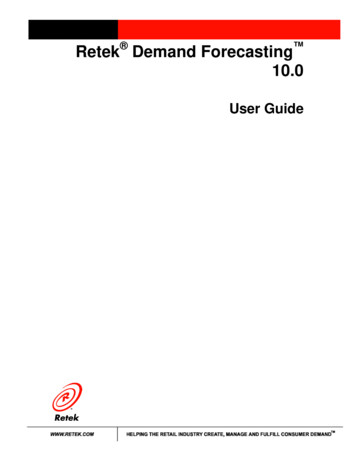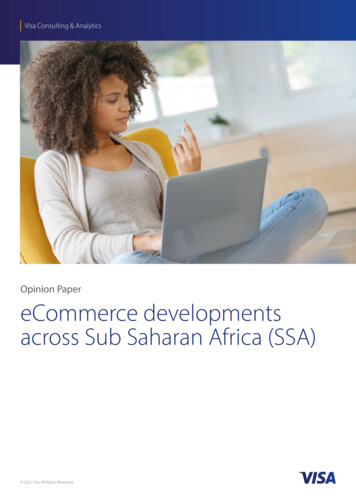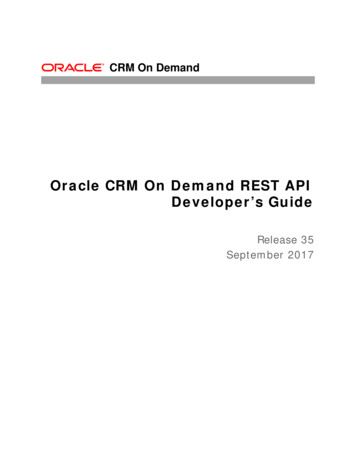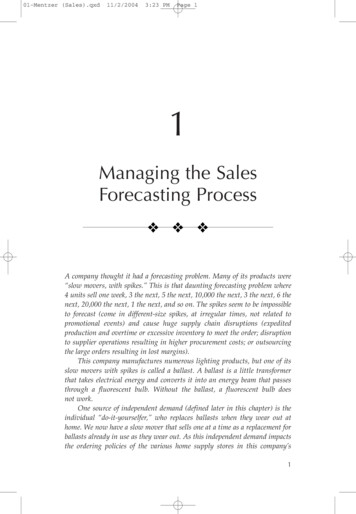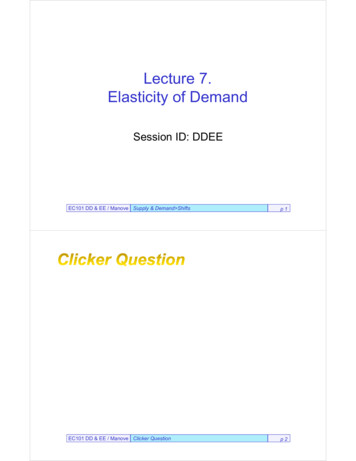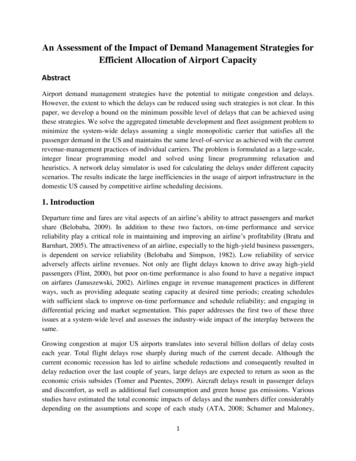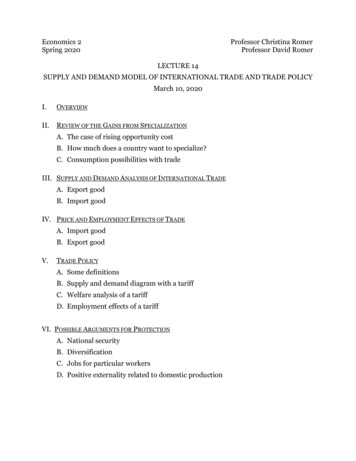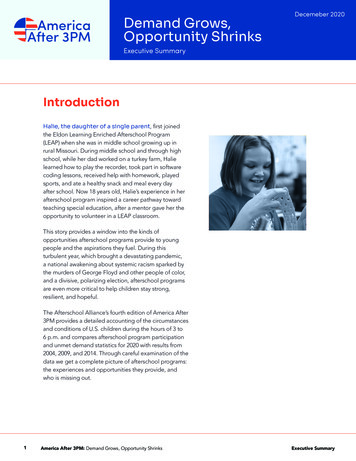
Transcription
AmericaAfter 3PMDemand Grows,Opportunity ShrinksDecemeber 2020Executive SummaryIntroductionHalie, the daughter of a single parent, first joinedthe Eldon Learning Enriched Afterschool Program(LEAP) when she was in middle school growing up inrural Missouri. During middle school and through highschool, while her dad worked on a turkey farm, Halielearned how to play the recorder, took part in softwarecoding lessons, received help with homework, playedsports, and ate a healthy snack and meal every dayafter school. Now 18 years old, Halie’s experience in herafterschool program inspired a career pathway towardteaching special education, after a mentor gave her theopportunity to volunteer in a LEAP classroom.This story provides a window into the kinds ofopportunities afterschool programs provide to youngpeople and the aspirations they fuel. During thisturbulent year, which brought a devastating pandemic,a national awakening about systemic racism sparked bythe murders of George Floyd and other people of color,and a divisive, polarizing election, afterschool programsare even more critical to help children stay strong,resilient, and hopeful.The Afterschool Alliance’s fourth edition of America After3PM provides a detailed accounting of the circumstancesand conditions of U.S. children during the hours of 3 to6 p.m. and compares afterschool program participationand unmet demand statistics for 2020 with results from2004, 2009, and 2014. Through careful examination of thedata we get a complete picture of afterschool programs:the experiences and opportunities they provide, andwho is missing out.1America After 3PM: Demand Grows, Opportunity ShrinksExecutive Summary
I. Unmet demand for afterschoolis at an all time highOver the years, the America After 3PMstudy has captured a continuouslyupward trend in the number of childrenwho are not in an afterschool programbut who would be enrolled in aprogram if one were available to them.The 2020 America After 3PM reportfinds a particularly dramatic escalationin the unmet demand for afterschoolprograms since the last survey, withnearly 25 million children who wouldbe enrolled in a program if one wereavailable to them. Now, for every childin an afterschool program, there arethree more children waiting to get in. National: Unmet demand forafterschool programs has grownfrom 15.3 million children (30percent) in 2004, to 18.5 millionchildren (38 percent) in 2009, to19.4 million children (41 percent)in 2014, to 24.6 million children(50 percent) in 2020. That isan increase of 60 percent overthe years this study has beenconducted. Children alone and unsupervisedafter school: The number ofchildren alone and unsupervisedafter school has continued todecline, reaching its lowest levelof 7.7 million children (13 percent)in 2020, from the peak of 15.1million children in 2009. However,while the number of middle andhigh school students on their ownafter school decreased from 2014,the number of elementary schoolstudents increased slightly, and isnow at more than 850,000.Traditionally underservedcommunities: Unmet demandis highest among traditionallyunderserved communities. Morethan half of Black (58 percent) andLatinx children (55 percent) whoare not in an afterschool programwould be enrolled in a program ifone were available. That comparesto 46 percent of White children.*State: From 2014 to 2020, all butsix states and Washington, D.C.saw an increase in unmet demandfor afterschool programs, withnearly half of states experiencinga double-digit percentage pointincrease in unmet demand.II. Demand surges as parents giveprograms high marks, recognizewide-ranging benefitsCombining the number of childrenalready in an afterschool programwith the number who would enrollin one if a program were availableto them provides a measure of theoverall demand for afterschool: 32.4million children (56 percent of allchildren). Based on parent responses,the growing demand reflects positiveexperiences with afterschool programsand growing appreciation of thesupports programs provide amongparents with a child in an afterschoolprogram, as well as parents ofnonparticipants.ɫ Growth in parent satisfaction:Satisfaction with programs isthe highest it has ever been; 94percent of parents report thatthey are satisfied with their child’safterschool program overall, anincrease from 89 percent in 2014.The intensity of satisfaction hasalso increased, with the number ofparents reporting being extremelysatisfied increasing from 50percent to 60 percent. Growing recognition ofbenefits: In 2020, even moreparents recognize the benefitsafterschool programs afford.For example, agreement thatafterschool programs helpchildren gain interest and skillsrelated to science, technology,* “Black” and “African American” and “Hispanic” and “Latinx” are used interchangeably throughout this report. Both “Black” and “White” are capitalized for the purposes ofthis report as referring to a racial and ethnic group of people.ɫThe America After 3PM survey is of parents or guardians of school-aged children. For the purposes of this report, “parents” is used to represent both parents and guardians.2America After 3PM: Demand Grows, Opportunity ShrinksExecutive Summary
engineering, and math (STEM)jumped 11 percentage points,from 65 percent in 2014 to 76percent in 2020, and agreementthat afterschool programs giveworking parents peace of mindgrew 8 percentage points, from 75percent to 83 percent.was important in their selection oftheir child’s afterschool program,76 percent report that their child’safterschool program offers classesor workshops, and 64 percentreport that their child’s afterschoolprogram connects them withcommunity resources.Multitude of benefits associatedIII. The opportunity gap is evidentwith afterschool programs:Parents agree that afterschoolprograms provide time for kidsto engage with their peers andreduce unproductive screen time(85 percent), get kids more excitedabout learning and interested inschool (74 percent), and reducethe likelihood that youth will usedrugs or engage in other riskybehaviors (75 percent). 3An increasingly positive viewof afterschool programs amongparents without a child in aprogram: Comparing 2014 to2020, parents of non-participantsare now more likely to agree thatafterschool programs help childrenbe physically active (73 percentvs. 83 percent), provide accessto caring adults and mentors(67 percent vs. 74 percent), andprovide opportunities to gain skillsrelated to STEM (61 percent vs. 75percent).Helping families and childrenin need: Three-quarters of lowincome families report that theavailability of snacks and mealsto affordability and availability ofafterschool programs compared toparents in 2014. National: There were doubledigit percentage point increasesin parents reporting that cost(increasing from 43 percent to57 percent), lack of availableprograms (increasing from 29percent to 42 percent), and a lackof a safe way for their childrento get to and come back fromprograms (increasing from 39percent to 53 percent) preventedthem from enrolling their child inan afterschool program. More barriers for low-incomefamilies and families of color:The barriers to enrolling children inan afterschool program increasedamong low-income families andare more prevalent among lowincome families than their higherincome peers. Among low-incomeparents, the percentage ofparents who report that cost wasa barrier increased 11 percentagepoints, from 50 percent in 2014to 61 percent in 2020. Comparedto higher income families, lowincome families were more likely toreport that cost and issues relatedto access, such as the lack of asafe way for their children to get toand from the program and lack ofavailable afterschool programs inthe area, as reasons they did notenroll their child in an afterschoolprogram.Children in low-income families havemore limited learning opportunitiesoutside of school compared to theirhigher income peers, including accessto afterschool programs. In 2020, America After 3PMfound that families in the highestincome bracket spend morethan five times as much on outof-school time activities per yearthan families in the lowest incomebracket, spending roughly 3,600annually versus 700.9 in 10 parents in the highestincome bracket (89 percent) reportthat their child participates inat least one out-of-school timeexperience, compared to 6 in10 parents in the lowest incomebracket.IV. Cost and access top the listof roadblocks to afterschoolparticipationIn this year’s America After 3PMsurvey, which gathered data beforethe pandemic, a greater percentageof parents report challenges relatedAmerica After 3PM: Demand Grows, Opportunity ShrinksExecutive Summary
While the majority of parentsacross groups report that costwas an important factor in theirdecision not to enroll their childin an afterschool program, AfricanAmerican and Hispanic parentsare more likely than White parentsto say that their children did nothave a safe way to get to and fromafterschool programs and thatprograms’ hours of operation andlocation presented challenges.in programs and benefiting fromthe offerings and supports theyprovide, compared to 10.2 millionchildren (18 percent) in 2014, 8.4million children (15 percent) in2009, and 6.5 million (11 percent)in 2004. Additionally, accessibility was agreater barrier for low-incomeparents of color than low-incomeWhite parents. African Americanand Hispanic parents who arelow-income (62 percent, both)were much more likely than Whiteparents who are low-income (54percent) to say that an importantreason they did not enroll theirchild in an afterschool programwas a lack of a safe way to getto and come home from theprogram.V. Afterschool participation falls;inequities prominentFor the first time in America After3PM’s 16-year history, afterschoolprogram participation has decreased.As a result, for every child in anafterschool program, three morechildren who want to participate in aprogram are unable to do so. 4National: In all, 7.8 million children(14 percent) are currently enrolled Demographics: Elementaryschool students continue tocomprise the largest age groupin afterschool programs (60percent), followed by middleschool students (21 percent), andhigh school students (19 percent).As in previous editions of AmericaAfter 3PM, White children makeup the overwhelming majority ofafterschool program participants(60 percent). However, 2020 sawchange in the overall compositionof afterschool programparticipants, and children ofcolor now make up 40 percent ofafterschool program participants.Children in higher incomefamilies comprise the majority ofafterschool program participants(66 percent), compared to 34percent of children living in lowincome households.Drop in afterschool programparticipation largely seenamong children living in lowincome households: While thereis an overall drop in access toafterschool opportunities for allyoung people, the America After3PM survey found that the youngpeople most affected are thoseAmerica After 3PM: Demand Grows, Opportunity Shrinksfrom low-income households. Thenumber of children in low-incomehouseholds in afterschool fell from4.6 million in 2014 to 2.7 millionin 2020. Meanwhile the numberof higher-income children inafterschool decreased by a fractionof that amount; 446,000 over thatsame time period.Based on responses from familieswith low income who do not havea child in an afterschool program,cost is a major driver behind thedecline in participation amonglow-income families, and pointsto a lack of available affordableprograms nationwide. However,public investments in afterschoolprograms—which help to makeprograms affordable for families—have not kept up with growingdemand since 2014. For instance,in spite of the increases in fundingsince 2014 for 21st CenturyCommunity Learning Centers (21stCCLC), the only federal fundingstream dedicated exclusively toafterschool, before-school, andsummer learning programs, haslagged behind the rate of inflationbetween 2014 and 2020 and isnow 10 million lower in inflationadjusted terms.21st CCLC and state-fundedprogram participation datasuggest that our nation’s publiclyfunded programs have been abackbone of support for manylow-income young people and thatExecutive Summary
without access to these programs,a significant number of low-incomeyoung people are being deniedthe opportunity to participate inafterschool programs.and competencies (96 percent),State: Reflecting the nationaltrend, all but four states saw adecline in afterschool programparticipation between 2014 and2020, with an average of a 3.6percentage point decrease.percent), and practice reading ormake time for physical activity (85percent), receive homework help(73 percent), take advantage ofSTEM learning opportunities (73writing (69 percent). Parent satisfaction: ParentsVII. Support for increasedinvestment in afterschool isgreater than everToday, most parents (84 percent) agreethat all young people deserve accessto quality afterschool and summerprograms. Support for public fundingfor afterschool programs has reachedan all-time high.report high levels of satisfactionwith the activities and supports offered by programs. A majorityof parents are in favor of publicof parents report satisfaction withfunding for programs that provideeach of the aspects of their child’safterschool opportunities toafterschool program the Americastudents in communities that haveAfter 3PM survey asked about,few opportunities for children andincluding 94 percent of parentsyouth, up from 84 percent in 2014reporting overall satisfaction withand 83 percent in 2009.their child’s experience in theirprimary afterschool program. percent), and urban parents (90parents satisfied with programAmerica After 3PM finds that childrenin afterschool programs have access toactivities that complement school daylearning as well as keep them active,build their life skills, and connect themto the community. Program offerings: Thepercent) support public funding forstaff (89 percent) and the programafterschool programs.offering opportunities to build lifeskills (84 percent). Supports for families: Whenasked about supports they receivefrom programs, 78 percent ofparents with a child enrolled inafterschool report that programshelp them keep their jobs, and 71percent say that programs allowoverwhelming majority of parentsthem to build their skills throughreport that their child’s afterschoolclasses or workshops offered.Community-type: More than 5 in6 rural (86 percent), suburban (87Other high-scoring areas areVI. Benefits are significant forchildren and families fortunateenough to participateNational: Overall, 87 percent Political affiliation: Support forpublic funding of afterschoolprograms is strong across politicalparties, with 91 percent of parentswho identify as Democrat, 87percent of parents who identifyas Independent, and 85 percentof parents who identity asRepublican, in favor of suchsupport.program offers the chance tobuild social and emotional skills5America After 3PM: Demand Grows, Opportunity ShrinksExecutive Summary
ConclusionWith more families struggling to afford and access an afterschool program,unmet demand hitting an all-time high, and parents with a child in an afterschool programreporting high levels of satisfaction with activities and supports offered by programs,it is clear there is a compelling need to increase access to afterschool programs. Theopportunity to participate in programs is shrinking, as cost and lack of affordableafterschool opportunities are denying a significant number of low-income young peopleaccess to afterschool programs.Public funding for afterschool programs helps provide affordable, quality programs formillions of children nationwide. Since the last edition of America After 3PM in 2014,public investments in afterschool programs have largely stalled. For instance, funding for21st Century Community Learning Centers, the only federal funding stream dedicatedexclusively to afterschool, before-school and summer learning programs, has not kept upwith the cost of inflation, increasing less than 9 percent between 2014 and 2020. In spiteof the increases in the 21st CCLC investment since 2014, the current funding level is 10million below the 2014 level. This backbone of support is critical, but it is not meeting theneed. A multi-faceted approach, with investments at the local, state, and federal levels ofgovernment, is necessary in order to create quality, affordable afterschool opportunities.The need for increased investment in afterschool is especially urgent with the coronaviruspandemic forcing many schools to move to a distance-learning model or operate ona hybrid schedule of in-person and virtual classes. An October 2020 survey of parentsfound that more than 3 in 4 agree that Congress should provide additional funding forafterschool programs to help provide a supervised, enriching environment during virtualschool days.If our country aims to give all children and youth the best chance to succeed in school andin life, and to provide equal opportunities for all young people, we must do much more tomake quality, affordable afterschool programs available to all.For more information about the national and state-specific America After 3PM surveyfindings, visit http://afterschoolalliance.org/AA3PM.The Afterschool Alliance is a nonprofit public awareness and advocacy organizationworking to ensure that all children and youth have access to quality afterschoolprograms. More information is available at www.afterschoolalliance.org.6America After 3PM: Demand Grows, Opportunity ShrinksExecutive Summary
MethodologyAmerica After 3PM is a nationally representative survey of randomly selected adultswho live in the United States and are the parent or guardian of a school-age child wholives in their household. The survey was conducted using a blend of national consumerpanels, with the goal of completing at least 200 interviews in every state and Washington,D.C. In states where this goal could not be reached using online panels, supplementarytelephone interviews were conducted. For the 2020 wave of America After 3PM,interviews were conducted in both English and Spanish.America After 3PM data included in this report were collected between January 27 andMarch 17, 2020. A total of 31,055 households were surveyed and answered questionsregarding ways in which their child or children are cared for in the hours after school.A subset of households, 14,391 respondents, answered a series of follow up questionsregarding afterschool experiences or barriers to participation in afterschool, andperceptions of afterschool programs. The overall margin of error for child-level andhousehold-level data is /- 1 percent.Projections for child-level data represent the 57.4 million children and youth in the UnitedStates based on numbers from the U.S. Census Bureau’s October 2018 Current PopulationSurvey.The October 2020 survey of parents was conducted by Edge Research and is a nationallyrepresentative online survey fielded October 12-29, 2020, of 1,202 parents of school-agedchildren.AcknowledgementsAmerica After 3PM 2020 is made possible with support from the New York LifeFoundation, Overdeck Family Foundation, The Wallace Foundation, the S.D. Bechtel, Jr.Foundation, Altria Group, the Walton Family Foundation, and the Charles Stewart MottFoundation.AmericaAfter 3PM
afterschool program inspired a career pathway toward teaching special education, after a mentor gave her the . 3PM provides a detailed accounting of the circumstances and conditions of U.S. children during the hours of 3 to 6 p.m. and compares afterschool program participation and unmet demand statistics for 2020 with results from 2004, 2009 .

